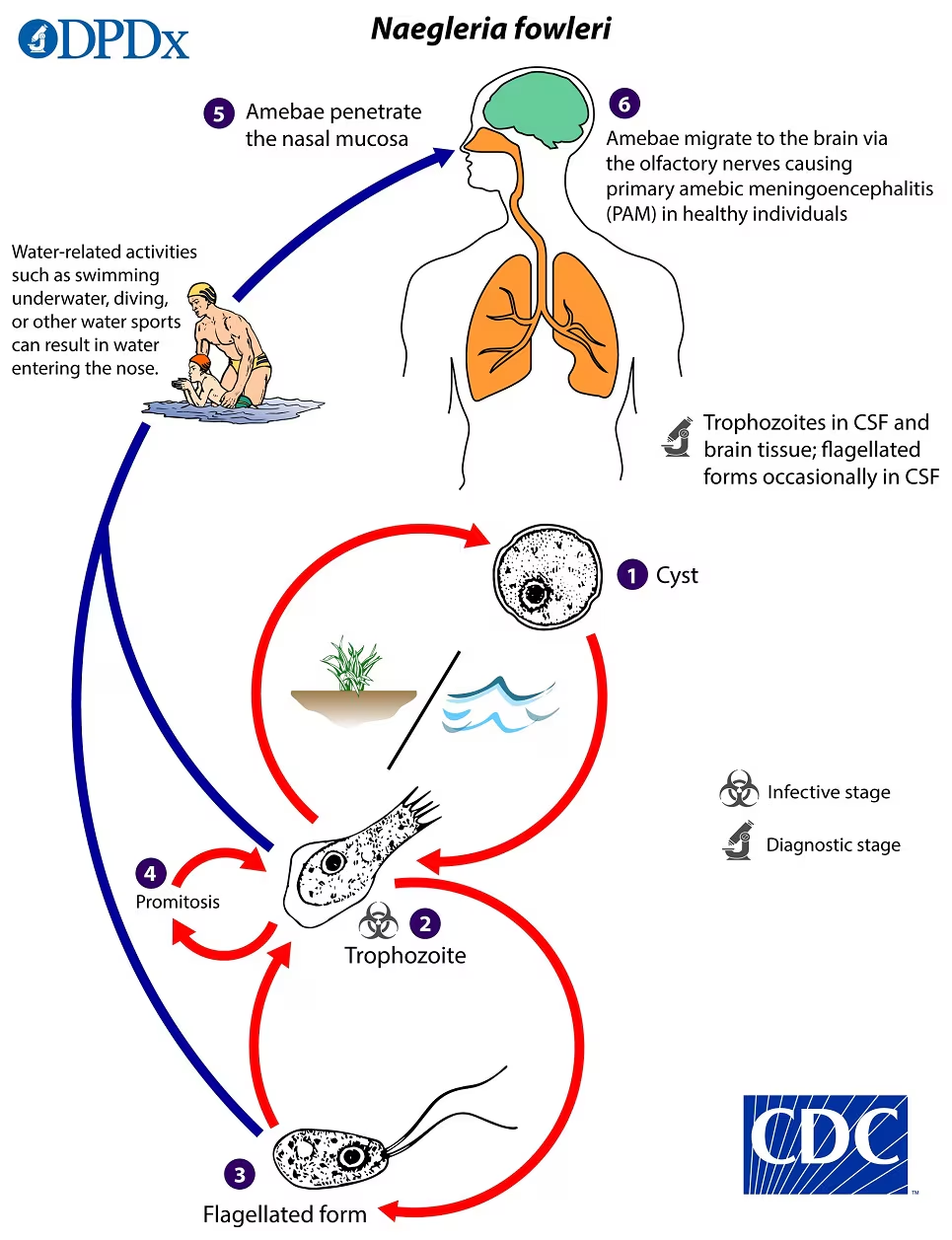15 Parasitology/ Mycology
Parasitology:
Activity 1:
Naegleria fowleri
Naegleria fowleri, often called the “brain-eating amoeba,” is a free-living microorganism found in warm freshwater environments such as lakes, rivers, and hot springs. This microscopic invader can cause Primary Amebic Meningoencephalitis (PAM), a rare but almost always fatal brain infection. Infections typically occur during the summer when higher water temperatures and activities like swimming or diving increase exposure risk. The amoeba infects individuals by entering the body through the nose, traveling along the olfactory nerve to the brain, where it destroys brain tissue.
Symptoms of PAM usually emerge 1–9 days after exposure and start with headache, fever, nausea, and vomiting. As the disease progresses, symptoms escalate to include a stiff neck, confusion, seizures, hallucinations, and eventually coma. Diagnosing N. fowleri involves examining cerebrospinal fluid (CSF) under a microscope to detect motile trophozoites, though polymerase chain reaction (PCR) tests and immunohistochemistry provide more definitive results. The amoeba’s life cycle includes three stages: the infectious trophozoite, a non-dividing flagellated form, and a dormant cyst stage. Only the trophozoite stage causes disease.
Treatment options are limited and must be started immediately due to the rapid progression of the infection. Amphotericin B, an antifungal medication, is the primary treatment, often administered directly into the spinal fluid or intravenously. Miltefosine, an experimental drug with amoebicidal properties, has shown potential when combined with intensive supportive care, including managing intracranial pressure. Although infections are rare, they are most common in warm climates, particularly in the southern United States, but have been reported worldwide. Efforts to improve diagnostic accuracy are ongoing, with advanced methods like next-generation sequencing offering hope for earlier and more precise detection.
https://www.cdc.gov/dpdx/freelivingamebic/index.html

Activity 2:
The Role of Parasites: Toxoplasma gondii and Behavior Changes
Toxoplasma gondii (T. gondii) is a single-celled parasite known to infect warm-blooded animals, including humans. Research into this parasite highlights its ability to influence host behavior, shedding light on the complex interactions between parasites and their hosts. The purpose of studying T. gondii extends beyond understanding its basic biology to exploring its effects on human mental health, animal behavior, and neurological conditions.
T. gondii can infect the brain and form cysts in neural tissue. Its life cycle relies on completing sexual reproduction within the intestines of felines, with other hosts, like rodents, serving as intermediate carriers. Studies have demonstrated that T. gondii-infected rodents exhibit reduced fear of cats, increasing the likelihood of predation, which ensures the parasite’s transmission to its definitive host.
The behavioral changes are believed to stem from altered neurotransmitter systems in the host brain. T. gondii infection can increase dopamine production, a neurotransmitter associated with reward, motivation, and fear processing. Additionally, the parasite may modulate inflammatory responses in the brain, further affecting neural circuits involved in behavior.
Human infections are widespread, with up to 30% of the global population carrying latent T. gondii. While most infections are asymptomatic, there is growing evidence linking the parasite to neurological and psychiatric disorders, including schizophrenia, bipolar disorder, and behavioral changes like risk-taking and impulsivity. These findings suggest T. gondii may influence human psychology in subtle yet significant ways.
The study of T. gondii highlights the evolutionary strategies of parasites and their capacity to manipulate host organisms to enhance survival. Understanding these mechanisms has implications for neuroscience, mental health, and public health. It also raises questions about how other pathogens may influence host behavior and biology in less apparent ways.
References
https://pmc.ncbi.nlm.nih.gov/articles/PMC1690701/
https://pubmed.ncbi.nlm.nih.gov/24662942/
https://pubmed.ncbi.nlm.nih.gov/2420295/
This research demonstrates the fascinating interplay between parasites and hosts, offering insights into how microbes may influence behavior on individual and population levels.
